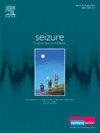一种新的SCN1A功能丧失变体与早发性复杂发热性癫痫发作有关
IF 2.8
3区 医学
Q2 CLINICAL NEUROLOGY
引用次数: 0
摘要
SCN1A基因的致病性变异是癫痫最常见的遗传原因之一,主要与全局性癫痫伴发热性癫痫发作(GEFS+)或Dravet综合征有关。我们提出了一种新的SCN1A变异在儿童治疗抵抗早发热性癫痫发作。方法对1例复发性热性惊厥患儿进行遗传分析。在非洲爪蟾卵母细胞和HEK293T细胞中对鉴定的变异进行了电生理表征。结果该患儿在5个月大时出现复杂的发热性癫痫发作,但在17个月大时症状显示为scn1a相关癫痫。遗传分析显示,SCN1A (NM_001165963.1)中有一个全新的错义变异:c.998C>;T, p.(Ala333Val)被归类为一个不确定意义的变异。该变异在gnomAD数据库中约80万个体中不存在,在临床数据库中也未报道。与野生型相比,NaV1.1A333V通道激活和通道可用性向去极化电位转移。NaV1.1A333V组Na+内流明显减少,表明功能丧失。意义:我们在一例复发性复杂热性惊厥患者中发现了NaV1.1A333V变异,功能特征表明存在功能缺失表型。SCN1A错义变异的功能特征可能为癫痫患者提供个性化的诊断信息,并改善治疗。本文章由计算机程序翻译,如有差异,请以英文原文为准。
A new loss-of-function variant in SCN1A is associated with early-onset complex febrile seizures
Objectives
Pathogenic variants in the SCN1A gene are among the most common genetic causes of epilepsy and are predominantly linked to Generalized Epilepsy with Febrile Seizures Plus (GEFS+) or Dravet syndrome. We present a new variant in SCN1A in a child with treatment-resistant early-onset febrile seizures.
Methods
We performed genetic analysis in a child presenting with recurrent febrile seizures. Electrophysiological characterization of the identified variant was performed in Xenopus laevis oocytes and HEK293T cells.
Results
The child presented with complex febrile seizures at age 5 months, but by age 17 months the symptoms indicated an SCN1A-related epilepsy. Genetic analyses revealed a de novo missense variant in SCN1A (NM_001165963.1): c.998C>T, p.(Ala333Val) classified as a variant of uncertain significance. The variant was absent from ∼800 000 individuals in the gnomAD database and is not reported in clinical databases. Compared to wildtype, NaV1.1A333V channel activation and channel availability shifted to depolarized potentials. Na+ influx was substantially reduced for NaV1.1A333V, indicative of loss-of-function.
Significance
We identified a NaV1.1A333V variant in a patient with recurrent complex febrile seizures, and functional characterization suggests a loss-of-function phenotype. Functional characterization of SCN1A missense variants may provide personalized diagnostic information in individuals with epilepsy, and improve treatment.
求助全文
通过发布文献求助,成功后即可免费获取论文全文。
去求助
来源期刊

Seizure-European Journal of Epilepsy
医学-临床神经学
CiteScore
5.60
自引率
6.70%
发文量
231
审稿时长
34 days
期刊介绍:
Seizure - European Journal of Epilepsy is an international journal owned by Epilepsy Action (the largest member led epilepsy organisation in the UK). It provides a forum for papers on all topics related to epilepsy and seizure disorders.
 求助内容:
求助内容: 应助结果提醒方式:
应助结果提醒方式:


